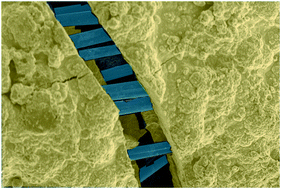Carbon-cloth-supported nickel hydroxide anodes for electrochemical–thermally-activated chemical (E-TAC) water splitting†
Abstract
Decoupled water splitting in an electrochemical–thermally-activated chemical (E-TAC) cycle is a promising path for safe, efficient and competitive production of green hydrogen at scale. Here, we demonstrate the performance of carbon-cloth-supported cobalt-doped nickel hydroxide anodes for E-TAC water splitting, and compare them with counterpart nickel-foam-supported anodes. The carbon-cloth-supported anodes are thinner, lighter and more flexible than their nickel-foam counterparts, and they show potential for cost reduction. Their lighter weight reduces the heat loss attributed to thermal swinging between the cold and hot stages in the E-TAC cycle. The nickel hydroxide layer coats the carbon fibers conformally and has a nano-flake microstructure that facilitates facile mass transport into the thick (up to 30 μm) layer. These characteristics allow high areal mass loading (>100 mg cm−2) of the electrochemically-active nickel hydroxide layer, and support reversible charge–discharge at high current densities (up to 20 mA cm−2) and capacities (up to 25 C cm−2), without concurrent oxygen evolution. Given the low thickness of these anodes (0.356 mm), their volumetric performance surpasses that of the much thicker (1.6 mm) nickel-foam-supported counterparts. Finally, the carbon-cloth-supported anodes facilitate chemical regeneration and oxygen evolution in hot (95 °C) electrolyte, enabling fully reversible E-TAC water splitting cycles with low anode charging potentials and no H2/O2 mixing in a membraneless architecture. Future efforts should concentrate on improving the active material utilization in the E-TAC water splitting cycles.



 Please wait while we load your content...
Please wait while we load your content...